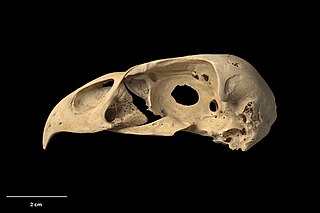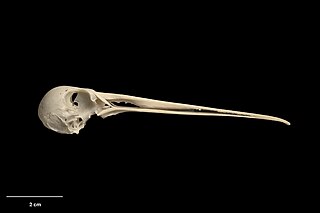
Moa are an extinct group of flightless birds formerly endemic to New Zealand. During the Late Pleistocene-Holocene, there were nine species. The two largest species, Dinornis robustus and Dinornis novaezelandiae, reached about 3.6 metres (12 ft) in height with neck outstretched, and weighed about 230 kilograms (510 lb) while the smallest, the bush moa, was around the size of a turkey. Estimates of the moa population when Polynesians settled New Zealand circa 1300 vary between 58,000 and approximately 2.5 million.

Rails are a large, cosmopolitan family of small- to medium-sized terrestrial and/or semi-amphibious birds. The family exhibits considerable diversity in its forms, and includes such ubiquitous species as the crakes, coots, and gallinule; other rail species are extremely rare or endangered. Many are associated with wetland habitats, some being semi-aquatic like waterfowl, but many more are wading birds or shorebirds. The ideal rail habitats are marsh areas, including rice paddies, and flooded fields or open forest. They are especially fond of dense vegetation for nesting. The rail family is found in every terrestrial habitat with the exception of dry desert, polar or freezing regions, and alpine areas. Members of Rallidae occur on every continent except Antarctica. Numerous unique island species are known.

The common moorhen, also known as the waterhen or swamp chicken, is a bird species in the rail family (Rallidae). It is distributed across many parts of the Old World, from Africa to Europe and Asia.

Moorhens—sometimes called marsh hens—are medium-sized water birds that are members of the rail family (Rallidae). Most species are placed in the genus Gallinula, Latin for "little hen." They are close relatives of coots. They are often referred to as (black) gallinules. Recently, one of the species of Gallinula was found to have enough differences to form a new genus Paragallinula with the only species being the lesser moorhen.

The laughing owl, also known as whēkau, the jackass, or the white-faced owl, is an extinct species of owl that was endemic to New Zealand. Plentiful when European settlers arrived in New Zealand, its scientific description was published in 1845, but it was largely or completely extinct by 1914. The species was traditionally considered to belong to the monotypic genus Sceloglaux Kaup, 1848, although recent genetic studies indicate that it belongs with the boobook owls in the genus Ninox.

The adzebills, genus Aptornis, were two closely related bird species, the North Island adzebill,, and the South Island adzebill,, of the extinct family Aptornithidae. The family was endemic to New Zealand. A tentative fossil species,, is known from the Miocene Saint Bathans fauna.

Eyles's harrier is an extinct bird of prey that was endemic to New Zealand.
The long-billed wren is an extinct species of New Zealand wren formerly endemic to the South Island of New Zealand. It was the only species in the genus Dendroscansor. It shares the name "long-billed wren" with the Brazilian bird Cantorchilus longirostris.

Forbes's snipe is an extinct species of New Zealand snipe formerly endemic to the Chatham Islands. It was the larger of two species found there, the smaller being the surviving Chatham snipe. It was never seen alive by scientists and is known only from fossil material collected on the islands. Why it became extinct while its smaller relative survived is a mystery, as is the exact timing of its extinction, although it may have survived, unnoticed, until the 15th century.
Scarlett's duck is an extinct duck species from New Zealand which was closely related to the Australian pink-eared duck. The scientific name commemorates the late New Zealand ornithologist and palaeontologist Ron Scarlett who discovered the holotype in 1941. However, previously undescribed bones of the species found in 1903 were rediscovered in the Otago Museum in 1998. At least 32 fossil remains from deposits in Pyramid Valley, at Ngāpara in the South Island, and at Lake Poukawa in the North Island are in museum collections.
Ronald Jack Scarlett was a New Zealand paleozoologist.
Pyramid Valley is a locality in the Hurunui District of New Zealand. It is well known for its prominent limestone rock formations. It is located near Waikari in the North Canterbury region, 80 km north-west of Christchurch.

The New Zealand goose is a bird of the extinct genus Cnemiornis of the family Anatidae, subfamily Anserinae. The genus, endemic to New Zealand, consisted of two species: the North Island goose, C. gracilis and the South Island goose C. calcitrans.
Scarlett's shearwater is an extinct species of seabird in the petrel family Procellariidae. Its common name commemorates New Zealand palaeontologist Ron Scarlett, who recognised the bird's subfossil remains represented a distinct species.

The snipe-rail is an extinct flightless rail endemic to the North Island of New Zealand. The species' name is derived from the Karamu Cave 21 kilometres (13 mi) from Hamilton where the holotype was discovered in 1954.

Zapornia is a recently revalidated genus of birds in the rail family Rallidae; it was included in Porzana for much of the late 20th century. These smallish to tiny rails are found across most of the world, but are entirely absent from the Americas except as wind-blown stray birds. A number of species, and probably an even larger number of prehistorically extinct ones, are known only from small Pacific islands; several of these lost the ability to fly in the absence of terrestrial predators. They are somewhat less aquatic than Porzana proper, inhabiting the edges of wetlands, reedbelts, but also drier grass- and shrubland and in some cases open forest.
Imber's petrel is an extinct seabird of gadfly petrel from the Chatham Islands. The species' epithet commemorates New Zealand ornithologist Mike Imber (1940–2011).
Richard Noel Holdaway is a New Zealand ornithologist. With a doctorate in avian palaeobiology and systematics and a BSc in neurophysiology and ornithology, he has studied birds for three decades primarily in New Zealand. In 2003 he received the 2003 D. L. Serventy Medal Holdaway is director of Palaecol Research Ltd in Christchurch, New Zealand. He was recognized for his findings on the extinction of the New Zealand terrestrial megafauna by the University of Otago. His work has also appeared in the New Zealand Journal of Zoology, Nature Communications, the US National Library of Medicine, National Institutes of Health and Royal Society Publishing among others.











